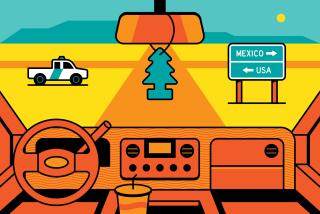The Curtain Rises: Eastern Europe, 1989 : BERLIN : The Wall--a Grim, Bloody Scar--Has Now Lost Its Horror : For 28 years it divided the German people--and the superpowers. Now visitors, seeking a memento of the Cold War, hammer away at it.
- Share via
BERLIN — Suddenly, after 28 years of a fearsome, almost obscene, presence, the Berlin Wall has lost its horror.
The Wall snakes its reptilian way, shimmering with colored graffiti, across the once and possibly future German capital, and is now visibly dying.
People beat on it with hammer and chisel, hawkers sell chunks of its concrete spine, strollers peer tentatively through the ruptures.
From the moment the Wall was breached on the memorable evening of Thursday, Nov. 9, its role as Europe’s most detested barrier began receding into history. Since it was raised in 1961, it had been a harsh, physical reminder of the division of Berlin, of the two Germanys, of East and West.
It has been stained with the blood of those breaking through to freedom: At least 80 people were killed trying to cross the Wall, 111 more along the West German border.
Thousands more, however, did succeed in fleeing--by tunnel, hidden under car floorboards, swimming the Elbe or Spree rivers, and even by hot-air balloon.
Who could forget the Wall’s harrowing images? The grim barbed wire and watchtowers, buildings demolished to create mine fields, a border guard suddenly leaping the wire into West Berlin, the snarling Alsatian patrol dogs, the bullet-riddled body of a teen-ager left to die slowly while East German guards made no move to help.
The East German guards were purposely not Berliners, cynical and questioning, but farm boys from rural Saxony who had few compunctions about obeying their lethal orders.
And so, manning the Wall, they helped to shape East Germany’s image as an unfeeling, brutal police state: the goose-stepping Nazis of communism.
The Wall also became the rhetorical podium for politicians speaking millions of words--the most eloquent those of U.S. President John F. Kennedy, who here reminded the world in 1963 that the defense of freedom meant we were all Berliners.
So when the Wall was finally and unexpectedly opened that Thursday, for those thousands who were there--and for millions who watched on television--the mood was utterly exhilarating.
People streamed through the crossing points in the glare of floodlights with a palpable air of disbelief--as if it were all a crazy dream, or conversely, as if the signals would change and the prison gates would be quickly shut again.
Berliners wept openly and embraced strangers at the crossing points, including the most famous of all, Checkpoint Charlie. Sparkling wine bottles were uncorked and passed around; later, huge throngs swept up the broad Kurfuerstendamm, West Berlin’s glittery main stem, and the noisy, smelly, tiny East German Trabant auto was the star of the hour.
But now, as euphoria dissipates in the gray December days, the Wall is seen by Berliners as a strange relic of the past while they routinely pass back and forth.
“We are just moving from one part of our city to another,” declares one East Berliner walking by. “This is the way it should be.”
And an East German border guard, bundled in a parka against the biting cold, agrees: “Everything is normal. No problem.”
But for some Berliners, the situation will not be normal until the avenue is opened through the Brandenburg Gate--the monument that symbolizes the city, a landmark like Paris’ Eiffel Tower and London’s Big Ben.
Many regard the Brandenburg Gate, a six-columned arch topped by the Goddess of Victory in a chariot pulled by four horses, as the ultimate symbol of German unity, of former Prussian greatness under kings and kaisers.
“This gate has meaning for many Germans,” says one West German visitor. “It gives us a national feeling, and we would like to see it opened again.”
A young carpenter from Dresden, striding through one of the Wall’s new crossing points into West Berlin with his wife, declares: “If the political situation continues like this, there will be no need for the Wall. Reunification is closer.”
And a West Berliner heading in the other direction agrees: “Maybe reunification happens much sooner than we imagined.”
“Maybe the Cold War is really going to end,” muses U.S. Sgt. Michael Rafferty, a lean, clipped-haired member of the Berlin Brigade at Checkpoint Charlie.
To be sure, many visitors are coming to Berlin these days for a glimpse of the Wall, even grabbing a fragment of the once-dreaded barrier.
“I wanted to come and see history being made,” explains Bill Gerber, a lanky young businessman from San Diego. “The Wall to me is a symbol of both freedom and repression.”
But as normality returns to Berlin, and perhaps Europe, the question is raised: What do to with the Wall?
Some believe it should be quickly torn down by the East Germans. A West German standing at one of the Wall’s crossings exclaims: “It’s such a horrible thing, nothing should remain.”
Others, however, suggest that the Wall should stand as a stark monument to the years of Communist repression--but also to man’s aspiration for freedom. THE CRUMBLING OF THE WALL
At least 14 Berlin Wall crossings have become available since Nov. 9, when East Germany removed restrictions on traveling to West Berlin. They are: (1) Wollank Strasse (2) Bornholmer Strasse (3) Eberswalder/Bernauer Strasse (4) Chaussee Strasse (5) Invalider Strasse (6) Friedrich Strasse (7) Jannowitz Bridge Subway Station (8) Potsdamer Platz (9) Friedrich Strasse/Zimmer Strasse (10) Heinrich Heine Strasse (11) Oberbaum Bridge (12) Puschkinallee (13) Sonnenallee (14) Stuebenrauch Strasse/Johannisthal Source: East German Embassy
More to Read
Sign up for Essential California
The most important California stories and recommendations in your inbox every morning.
You may occasionally receive promotional content from the Los Angeles Times.













